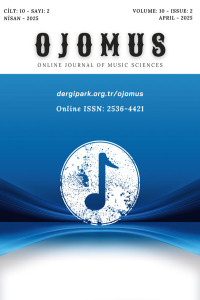Abstract
Contemporary Turkish composer Hatıra Ahmedli Cafer was born in Baku and started her piano education at a young age. When the composer’s works are analyzed, it is seen that she intensively uses the piano as a basic means of expression, reflecting technical mastery and artistic depth. While containing different piano techniques in her works, she also blends elements of folk music with a modern understanding, presenting a unique synthesis of traditional and contemporary musical languages.
This study is a comprehensive analysis of Ahmedli Cafer’s piano piece titled “Üç Bayatı”, composed in 1996. The work not only demonstrates the composer’s technical and artistic competence in piano writing, but also her ability to interpret Azerbaijani folk music traditions from an innovative perspective. The research aims to gain a more detailed understanding of Ahmedli Cafer’s artistic vision and her contributions to contemporary Turkish-Azerbaijani music through an in-depth study of the stylistic, structural and technical characteristics of “Üç Bayatı”. The data for this study is based on the performance of the works, analysis of the recordings and analysis of the notation. The anonymous Bayati in Azerbaijani oral literature inspired the composer’s piano piece titled “Üç Bayatı” (Three Bayati). Inspired by the folklore, the composer has carried the expression and timbre possibilities of the piano beyond the traditional patterns with an innovative writing technique. The Bayati, which are expressed in 7 syllables and quatrains in oral literature, were completed to 33 measures in the 1st and 3rd Bayati by the composer, while the 2nd Bayati, despite its unmetered structure, was designed to correspond to 33 measures in 2/4 beats.
Project Number
-
References
- Ahmedli Cafer, H. (1996). 3 Bayatı [Müzik Notası]. Hatıra Ahmedli Cafer Kişisel Arşiv.
- Ahmedli Cafer, H. (2015). Dünden bugüne Azerbaycan müziği üzerine bir değerlendirme. İdil Dergisi, 4(17), 135-146. https://doi.org/10.7816/idil-04-17-09
- Creswell, J. W. (2014). Research design: Qualitative, quantitative, and mixed methods approaches. Sage Publications.
- Farhadova, S. T. (1992). Azerbaycan ağıt ezgilerinin eski formları hakkında Azerbaycan milli musikisinin tadgigi problemleri, 17-19 Aralık 1991 [Yayımlanmış bildiri]. I. Respublika Elmi Konferansının Materyalları, Bakü, Azerbaycan.
- Pınar, M. (2023). Kadın besteci Hatıra Ahmedli Cafer’in besteleriyle toplumsal olaylara verdiği tepki. Premium E-Journal of Social Sciences (PEJOSS), 7(35), 1358-1365. https://doi.org/10.5281/zenodo.10030060
- Schoenberg, A. (1987). Theory of harmony. University of California Press.
- Smith, J. (2004). Modern rhythms in contemporary music. Oxford University Press.
- Sontag, S. (1977). On photography. Farrar, Straus, and Giroux.
- Tyulin, Y. N. (1974). Müzik formu. Muzıka Yayınları.
- Yin, R. K. (2018). Case study research and applications: Design and methods. Sage Publications.
Abstract
Çağdaş Türk besteci Hatıra Ahmedli Cafer, Bakü’de doğmuş ve piyano eğitimine genç yaşlarda başlamıştır. Bestecinin eserleri incelendiğinde, piyanoyu temel bir ifade aracı olarak yoğun bir şekilde kullandığı, teknik ustalığı ve sanatsal derinliği yansıttığı görülmektedir. Ahmedli Cafer, eserlerinde farklı piyano tekniklerini barındırmakla beraber, aynı zamanda halk müziği unsurlarını modern bir anlayışla harmanlayarak geleneksel ve çağdaş müzik dillerinin özgün bir sentezini sunmaktadır.
Bu çalışma, Ahmedli Cafer’in 1996 yılında bestelemiş olduğu Üç Bayatı adlı piyano eserinin kapsamlı bir analizini içermektedir. Söz konusu eser, bestecinin piyano yazımındaki teknik ve sanatsal yetkinliğini sergilemekle kalmayıp, Azerbaycan halk müziği geleneklerini yenilikçi bir bakış açısıyla yorumlama becerisini de ortaya koymaktadır. Araştırma, Üç Bayatı’nın stilistik, yapısal ve teknik özelliklerini derinlemesine inceleyerek, Ahmedli Cafer’in sanatsal vizyonu ve çağdaş Türk-Azerbaycan müziğine olan katkılarını daha ayrıntılı bir şekilde anlamayı hedeflemektedir. Bu çalışmada veriler, eserlerin icra edilmesi, kayıtların analiz edilmesi ve nota üzerinde yapılan incelemelerle elde edilmiştir. Azerbaycan sözlü edebiyatında anonim olarak yer alan bayatılar, bestecinin Üç Bayatı adlı piyano eserine ilham kaynağı olmuştur. Halk folklorundan esinlenen besteci, eserinde yenilikçi bir yazım tekniğiyle piyanonun ifade ve tını olanaklarını geleneksel kalıpların ötesine taşımıştır. Sözlü edebiyatta 7 heceli ve dörtlük yapısında ifade edilen Bayatılar, besteci tarafından 1. ve 3. Bayatılarda 33 ölçüye tamamlanmış, 2. Bayatı ise ölçüsüz yapısına rağmen 2/4 vuruşla 33 ölçüye denk gelecek şekilde tasarlanmıştır.
Ethical Statement
-
Supporting Institution
-
Project Number
-
Thanks
-
References
- Ahmedli Cafer, H. (1996). 3 Bayatı [Müzik Notası]. Hatıra Ahmedli Cafer Kişisel Arşiv.
- Ahmedli Cafer, H. (2015). Dünden bugüne Azerbaycan müziği üzerine bir değerlendirme. İdil Dergisi, 4(17), 135-146. https://doi.org/10.7816/idil-04-17-09
- Creswell, J. W. (2014). Research design: Qualitative, quantitative, and mixed methods approaches. Sage Publications.
- Farhadova, S. T. (1992). Azerbaycan ağıt ezgilerinin eski formları hakkında Azerbaycan milli musikisinin tadgigi problemleri, 17-19 Aralık 1991 [Yayımlanmış bildiri]. I. Respublika Elmi Konferansının Materyalları, Bakü, Azerbaycan.
- Pınar, M. (2023). Kadın besteci Hatıra Ahmedli Cafer’in besteleriyle toplumsal olaylara verdiği tepki. Premium E-Journal of Social Sciences (PEJOSS), 7(35), 1358-1365. https://doi.org/10.5281/zenodo.10030060
- Schoenberg, A. (1987). Theory of harmony. University of California Press.
- Smith, J. (2004). Modern rhythms in contemporary music. Oxford University Press.
- Sontag, S. (1977). On photography. Farrar, Straus, and Giroux.
- Tyulin, Y. N. (1974). Müzik formu. Muzıka Yayınları.
- Yin, R. K. (2018). Case study research and applications: Design and methods. Sage Publications.
Details
| Primary Language | Turkish |
|---|---|
| Subjects | Interpretation in Western Classical Music, Music Cognition, Music (Other) |
| Journal Section | Research article |
| Authors | |
| Project Number | - |
| Publication Date | April 30, 2025 |
| Submission Date | January 24, 2025 |
| Acceptance Date | March 27, 2025 |
| Published in Issue | Year 2025 Volume: 10 Issue: 2 |


